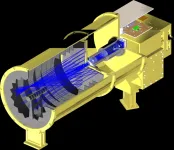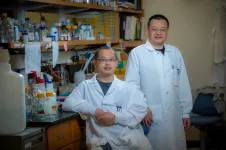(Press-News.org) New Method Uses Engineered Bacteria and AI to Sense and Record Environmental Signals
Columbia synthetic biologists first to engineer bacterial swarm patterns to visibly record environment, use deep learning to decode patterns; applications could range from monitoring environmental pollution to building living materials
New York, NY—May 9, 2023—Researchers in Biomedical Engineering Professor Tal Danino’s lab were brainstorming several years ago about how they could engineer and apply naturally-pattern-forming bacteria. There are many bacteria species, such as Proteus mirabilis (P. mirabilis), that self-organize into defined patterns on solid surfaces that are visible to the naked eye. These bacteria can sense several stimuli in nature and respond to these cues by “swarming”—a highly coordinated and rapid movement of bacteria powered by their flagella, a long, tail-like structure that causes a whip-like motion to help propel them.
For inspiration, Danino’s team at Columbia Engineering, which has a good deal of experience using synthetic biology methods to manipulate bacteria, discussed where else they might find similar patterns in nature and what their functions might be. They noted how tree rings record tree age and climate history, and that sparked their idea of applying P. mirabilis rings as a recording system. They had also been interested in applying AI to characterize the distinct features of bacterial colony patterns, an approach that they realized could then be used to decode an engineered pattern.
“This seemed to us to be an untapped opportunity to create a natural recording system for specific cues,” said Danino, a member of Columbia’s Data Science Institute (DSI).
In a new study, published May 4 in Nature Chemical Biology, the researchers worked with P. mirabilis, commonly found in the soil and water and occasionally the human gut, known for its bullseye-appearing colony patterns. When the bacteria are grown on a Petri dish of a solid growth media, they alternate between phases of bacterial growth, which make visible dense circles, and bacterial movement, called “swarming” movement, which expands the colony outwards. EMBED VIDEO HERE
The team engineered the bacteria by adding what synthetic biologists call “genetic circuits”—systems of genetic parts, logically compiled to make the bacteria behave in a desired way. The engineered bacteria sensed the presence of the researchers’ chosen input—ranging from temperature to sugar molecules to heavy metals such as mercury and copper—and responded by changing their swarming ability, which visibly changed the output pattern.
Working with Andrew Laine, Percy K. and Vida L. W. Hudson Professor of Biomedical Engineering and a DSI member and Jia Guo, assistant professor of neurobiology (in psychiatry) at the Columbia University Irving Medical Center the researchers then applied deep learning–a state-of-the-art AI technique–to decode the environment from the pattern, in the same way scientists look at the rings in a tree trunk to understand the history of its environment. They used models that can classify patterns holistically to predict, for example, sugar concentration in a sample, and models that can delineate or “segment” edges within a pattern to predict, for example, the number of times the temperature changed while the colony grew.
An advantage of working with P. mirabilis is that, compared to many of the typical engineered bacterial patterns, the native P. mirabilis pattern is visible to the naked eye without costly visualization technology and forms on a durable, easy-to-work-with solid agar medium. These properties increase the potential to apply the system as a sensor readout in a variety of settings. Using deep learning to interpret the patterns can enable researchers to extract information about input molecule concentrations from even complex patterns.
“Our goal is to develop this system as a low-cost detection and recording system for conditions such as pollutants and toxic compounds in the environment ,” said Anjali Doshi, the study’s lead author and a recent PhD graduate from Danino’s lab. “To our knowledge, this work is the first study where a naturally pattern-forming bacterial species has been engineered by synthetic biologists to modify its native swarming ability and function as a sensor.”
Such work can help researchers better understand how the native patterns form, and beyond that, can contribute to other areas of biotechnology beyond the area of sensors. Being able to control bacteria as a group rather than as individuals, and control their movement and organization in a colony, could help researchers build living materials at larger scales, and help with the Danino lab's parallel goal of engineering bacteria to be living "smart" therapeutics, by enabling better control of bacterial behaviors in the body.
This work is a new approach for building macroscale bacterial recorders, expanding the framework for engineering emergent microbial behaviors. The team next plans to build on their system by engineering the bacteria to detect a wider range of pollutants and toxins and moving the system to safe "probiotic" bacteria. Ultimately, they aim to develop a device to apply the recording system outside of the lab.
###
About the Study
Journal: Nature Chemical Biology
The study is titled “Engineered bacterial swarm patterns as spatial records of environmental inputs.”
Authors are: Anjali Doshi 1 , Marian Shaw 1 , Ruxandra Tonea1 , Soonhee Moon1 , Rosalía Minyety1 , Anish Doshi2 , Andrew Laine1 , Jia Guo3,4 & Tal Danino 1,5,6
1 Department of Biomedical Engineering, Columbia University
2 Department of Electrical Engineering and Computer Sciences, University of California, Berkeley
3 Department of Psychiatry, Columbia University
4 Mortimer B. Zuckerman Mind Brain Behavior Institute, Columbia University
5 Herbert Irving Comprehensive Cancer Center, Columbia University
6 Data Science Institute, Columbia University
This work was supported by an NSF CAREER Award (1847356 to T.D.), Blavatnik Fund for Innovations in Health (T.D.), and NSF Graduate Research Fellowship (A.D., Fellow ID 2018264757).
A.D., M.S., J.G., A.L. and T.D. are named as inventors on a provisional patent application that has been filed by Columbia University with the US Patent and Trademark Office related to all aspects of this work. The remaining authors declare no competing interests.
###
LINKS:
Paper: https://www.nature.com/articles/s41589-023-01325-2
DOI: 10.1038/s41589-023-01325-2
###
END
New method uses engineered bacteria and AI to sense and record environmental signals
Columbia synthetic biologists first to engineer bacterial swarm patterns to visibly record environment, use deep learning to decode patterns; applications could range from monitoring environmental pollution to building living materials
2023-05-09
ELSE PRESS RELEASES FROM THIS DATE:
Increasing prosperity linked to unhealthy eating patterns in Kenyan youth
2023-05-09
Philadelphia, May 9, 2023 – The increase in obesity in lower-middle-income countries (LMIC) is largely thought to be affected by lifestyle transition away from traditional diets toward unhealthy Western dietary patterns that follow economic development. This study in the Journal of Nutrition Education and Behavior, published by Elsevier, collected data on eating and physical activity behaviors from families in two socioeconomically-different communities in Nairobi, Kenya. Researchers found that increasing prosperity is linked to unhealthy eating patterns in Kenyan preadolescents.
"Dietary ...
Systematic racism in healthcare boosted COVID-19 vaccine mistrust in Black communities: Study
2023-05-09
The University of Ottawa’s Interdisciplinary Centre for Black Health survey reveals scope of coronavirus vaccine hesitancy in Black communities in relation to healthcare.
The health care system must play a significant role in combatting COVID-19 mistrust among Black individuals in Canada according to a new University of Ottawa study that found distrust in the healthcare network was so profound that educated individuals were hesitant to receive the vaccine.
Professor Jude Mary Cénat, Associate Professor in the School of Psychology at the Faculty of Social Sciences, is the Chair of the Interdisciplinary Centre ...
Hey Siri, can you hear me? #ASA184
2023-05-09
CHICAGO, May 9, 2023 – Millions of people now regularly communicate with AI-based devices, such as smartphones, speakers, and cars. Studying these interactions can improve AI’s ability to understand human speech and determine how talking with technology impacts language.
In their talk, “Clear speech in the new digital era: Speaking and listening clearly to voice-AI systems,” Georgia Zellou and Michelle Cohn of the University of California, Davis will describe experiments to investigate how speech and comprehension change when humans communicate ...
Lack of belief in body’s ability to function through pain linked to daily pre-surgery prescribed opioid use among candidates for elective spine surgery
2023-05-09
According to a new Johns Hopkins Medicine study, low pain self-efficacy can predict daily pre-surgery prescribed opioid use among patients seeking elective spine surgery. The study defined pain self-efficacy as the “beliefs held by people with chronic pain that they can carry out certain activities, even when experiencing pain.” Previous studies showed that lower pain self-efficacy is associated with higher pain intensity and greater pain interference in day-to-day life. However, the Johns Hopkins research team believes its study is among the first to investigate ...
Reduced cancer mortality with daily vitamin D intake
2023-05-09
Vitamin D intake could reduce cancer mortality in the population by twelve percent - provided the vitamin is taken daily. This was the result of an evaluation of 14 studies of the highest quality conducted at the German Cancer Research Center with a total of almost 105,000 participants.
Vitamin D deficiency is widespread worldwide and is particularly common among cancer patients. Averaged over the year, the vitamin D blood levels of about 15 percent of German adults are below the threshold for a pronounced vitamin D deficiency*. In contrast, in a study of colorectal ...
Scientists develop AI tool to predict Parkinson’s disease onset
2023-05-09
Scientists from UNSW Sydney with collaborators at Boston University have developed a tool that shows early promise in detecting Parkinson’s disease years before the first symptoms start appearing.
In research published today in the journal ACS Central Science, the researchers described how they used neural networks to analyse biomarkers in patients’ bodily fluids.
The researchers from UNSW School of Chemistry examined blood samples taken from healthy individuals gathered by the Spanish European ...
SwRI selected for Phase A study to develop next-generation NOAA coronagraph
2023-05-09
SAN ANTONIO — May 9, 2023 —NASA has selected Southwest Research Institute for a Phase A study to develop SwRI’s Space Weather Solar Coronagraph (SwSCOR) on behalf of the National Oceanic and Atmospheric Administration (NOAA). NOAA’s Space Weather Next Program is charged with providing critical data for its space weather prediction center. SwRI is one of five organizations developing a definition-phase study to produce the next-generation NOAA L1 Series COR instrument to detect and characterize Earth-directed coronal mass ejections (CMEs).
CMEs are huge bursts of coronal plasma threaded with intense magnetic fields ...
Long molecule of RNA essential to our GI tract’s ability to contract and move food along
2023-05-09
AUGUSTA, Ga. (May 9, 2023) – A long molecule of RNA found in abundance in the healthy smooth muscle cells that give our blood vessels strength and flexibility is also essential to the continuous contraction that moves food through our gastrointestinal tract.
Without CARMN, a long, noncoding RNA, which means it doesn’t produce proteins but does help regulate cell activity, the 30-foot-long GI tract doesn’t contract as it should.
That can result in a painful even lethal situation where partially undigested food gets ...
A CRISPR-edited calf shows virus resistance
2023-05-09
A gene-edited calf shows resistance to a common bovine virus. Bovine viral diarrhea virus (BVDV) causes gastrointestinal and respiratory symptoms as well as reproductive failure in cattle around the world. Vaccines against the virus exist but the virus evolves quickly and vaccines are not always fully protective. Aspen Workman and colleagues used the CRISPR/Cas9 system to swap out just six amino acids in the bovine CD46 receptor in one calf. The calf showed a dramatic reduction in susceptibility to the virus and ...
Potential found to counter depression by restoring key brain rhythm
2023-05-09
Led by researchers from NYU Grossman School of Medicine and University of Szeged in Hungary, a new study in mice and rats found that restoring certain signals in a brain region that processes smells countered depression.
Publishing in the journal Neuron online May 9, the study results revolve around nerve cells (neurons), which “fire” – or emit electrical signals – to transmit information. Researchers in recent years discovered that effective communication between brain regions ...
LAST 30 PRESS RELEASES:
New expert guidance urges caution before surgery for patients with treatment-resistant constipation
Solar hydrogen can now be produced efficiently without the scarce metal platinum
Sleeping in on weekends may help boost teens’ mental health
Study: Teens use cellphones for an hour a day at school
After more than two years of war, Palestinian children are hungry, denied education and “like the living dead”
The untold story of life with Prader-Willi syndrome - according to the siblings who live it
How the parasite that ‘gave up sex’ found more hosts – and why its victory won’t last
When is it time to jump? The boiling frog problem of AI use in physics education
Twitter data reveals partisan divide in understanding why pollen season's getting worse
AI is quick but risky for updating old software
Revolutionizing biosecurity: new multi-omics framework to transform invasive species management
From ancient herb to modern medicine: new review unveils the multi-targeted healing potential of Borago officinalis
Building a global scientific community: Biological Diversity Journal announces dual recruitment of Editorial Board and Youth Editorial Board members
Microbes that break down antibiotics help protect ecosystems under drug pollution
Smart biochar that remembers pollutants offers a new way to clean water and recycle biomass
Rice genes matter more than domestication in shaping plant microbiomes
Ticking time bomb: Some farmers report as many as 70 tick encounters over a 6-month period
Turning garden and crop waste into plastics
Scientists discover ‘platypus galaxies’ in the early universe
Seeing thyroid cancer in a new light: when AI meets label-free imaging in the operating room
Neutrophil-to-lymphocyte ratio may aid risk stratification in depressive disorder
2026 Seismological Society of America Annual Meeting
AI-powered ECG analysis offers promising path for early detection of chronic obstructive pulmonary disease, says Mount Sinai researchers
GIMM uncovers flaws in lab-grown heart cells and paves the way for improved treatments
Cracking the evolutionary code of sleep
Medications could help the aging brain cope with surgery, memory impairment
Back pain linked to worse sleep years later in men over 65, according to study
CDC urges ‘shared decision-making’ on some childhood vaccines; many unclear about what that means
New research finds that an ‘equal treatment’ approach to economic opportunity advertising can backfire
Researchers create shape-shifting, self-navigating microparticles
[Press-News.org] New method uses engineered bacteria and AI to sense and record environmental signalsColumbia synthetic biologists first to engineer bacterial swarm patterns to visibly record environment, use deep learning to decode patterns; applications could range from monitoring environmental pollution to building living materials







